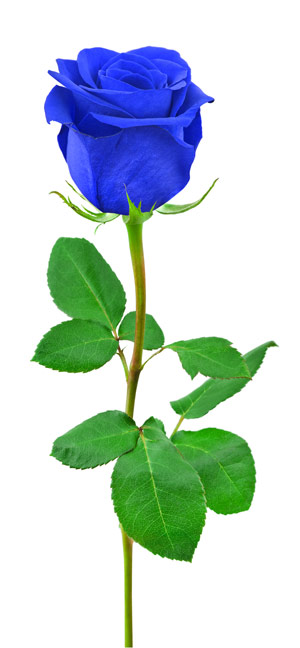The blue rose

Roses are red, Violets are blue, Honey is sweet, and so are you
This well-known rhyme consists of four statements. The writer is clearly wanting one to agree that since the first three are ‘proven facts’, therefore the last should be accepted also. But are the first three really always true? For example, are roses always red? Why can’t a rose be blue?
About eight species of rose occur naturally, and none of them are blue. For centuries, rose enthusiasts have been breeding new varieties of roses, but the lack of naturally occurring blue pigment in any rose was a frustration to rose growers. They experimented with all sorts of breeding in attempts to be the first to produce a blue rose, success in which would be a commercial bonanza. However, no amount of hybridization, careful selection, or any other conventional process usually used by plant breeders, including changing environmental factors such as soil types, ever produced anything near blue colouration in any type of rose.
The ‘impossible dream’
This lack of progress in spite of worldwide interest led to the blue rose becoming a symbol for a non-existent object. Producing one was regarded as an impossible dream akin to alchemy. One company attempting the feat called it their ‘dreamful project’.
But such hard work involving ‘natural’ processes was useless. Quite simply, a plant can only produce blue flowers if it has the genes—instructions ‘written’ on its DNA—for manufacturing a blue pigment, such as delphinidin.1 And roses did not have those genes when our little poem was written. Obviously, production of a blue rose would have to await a method of introducing the genes for manufacturing delphinidin from another species of plant to the rose genome, and that process is not as simple as it sounds. It only became possible in the 1980s with the genetic research and discoveries by many teams around the world. These most famously led to the invention of the ‘gene gun’ by creationist geneticist Dr John Sanford, a technology which led to many genetic modification successes.2
First, the genes that enable a plant to produce blue pigment had to be isolated from the tens of thousands of genes located on the chromosomes in the world’s blue-flowered plants. The successful company (a subsidiary of Japanese firm Suntory) eventually used petunias, with their over 30,000 kinds of genes. They chose a variety that bore a dark violet flower.
Next, the relevant genes had to be introduced to rose plants and tested to ensure they were not only expressed in mature plants, but also confined to the petals—we don’t want roses with blue leaves or stems.3 This testing takes a long time unless you use something like yeast cells for multiplication rather than adult rose plants grown from seed.
Eventually, after much secret work and the expenditure of three billion yen (c. $US 25 million) by Suntory, the London Telegraph could make the 2008 announcement: “World’s first blue roses after 20 years of research”.4
That’s a huge amount of effort and directed intelligence just to produce a blue rose. Yet many claim that all of the amazing life forms on Earth evolved by random mutation of DNA sifted by natural selection over millions of years. The DNA instructions for producing blue pigment in petunias and many other flowering plants, or the pigment that gives a red rose its colour, are all assumed to have evolved this way.
In reality, such genes are not the result of any evolutionary process at all. Instead, God created the programming during Creation Week about 6,000 years ago. And not only petunias and roses, but the original (parent) kinds of every other living creature in the world. The codes for such complex instructions do not just happen ‘naturally’, i.e. by themselves—the years of intelligent effort involved in this ‘dreamful project’ illustrate that.5
References and notes
- Strictly speaking, it could produce a blue colour if it had genes to manufacture a very special surface structure that leads to optical interference, such as is found in the wings of the Ulysses butterfly. In this, a black-brown pigment looks iridescent blue at the right angle. See creation.com/blue. Return to text.
- Batten, D., Plant geneticist: ‘Darwinian evolution is impossible’, Creation 30(4): 45–47, 2008; creation.com/sanford. Return to text.
- See reference to an unsuccessful attempt to produce a blue rose using hydrangea genes in creation.com/frankenstein-foods (the rose had the wrong pH, i.e. acid-base balance). Return to text.
- Demetriou , D., World’s first blue roses after 20 years of research, telegraph.co.uk, 31 October 2008. The roses had been produced in the lab four years earlier, prior to testing to establish they were safe to grow in nature. Return to text.
- Note that the introduced genes have not been observed to evolve by mutation, but are already-existing DNA strands from other plants. Mathematical simulations by Dr Sanford and others show that even given millions of years, mutations cannot achieve such creative changes. Return to text.





Readers’ comments
Comments are automatically closed 14 days after publication.